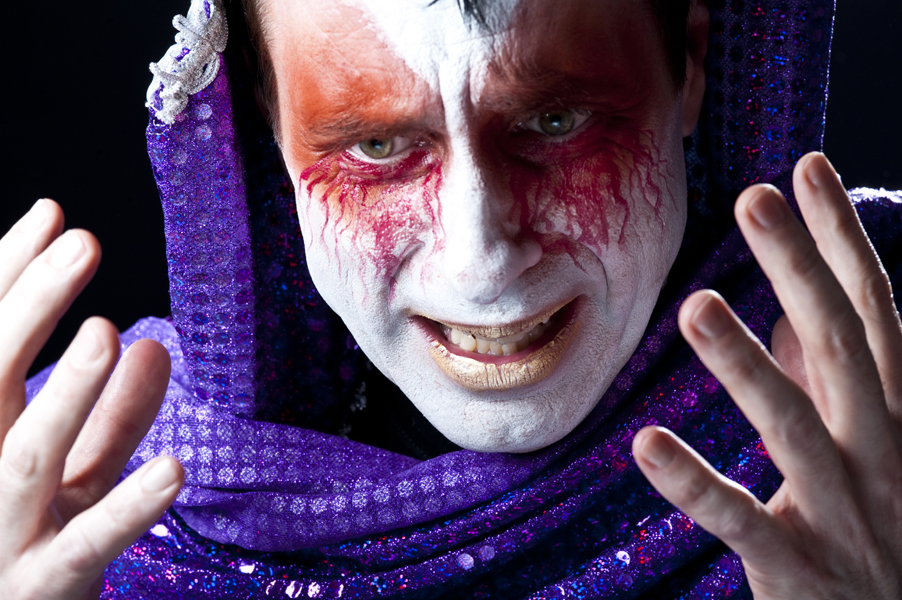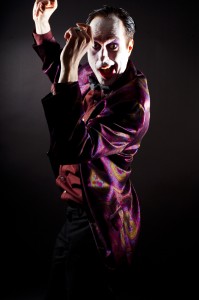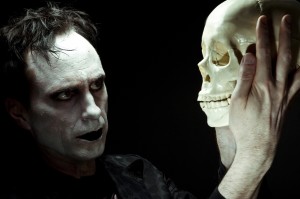
Bill Connington as Oedipus (photo by Beau Allulli)
When looking for a quote to use as a title for this fantastic interview you’re about to read I had so many, many wonderful choices. Ultimately I went with a more benign line from the Megadeath song but I urge you to check out the Alice Cooper ode to the dark one as well as the more contemplative song brought to us by the Indigo Girls. Maybe even play it in the background to set the tone as you settle in to read my interview with Rachel Klein and Bill Connington.
If those names sound familiar it may be because Rachel Klein has done amazing work with shows like All Kinds of Shifty Villains and Go-Go Killers! while Bill Connington garnered raves in Fringe ’08 with Zombie. Ms. Klein now teams up with Mr. Connington to not only direct a show he has written and is performing in, but to create dance and movement pieces for it as well. I got a chance to chat with Klein and Connington about their new collaboration, Princes of Darkness, and hear first hand about good and evil, how go-go dancing can still be dystopian, and how, often, a Jesuit education will lead to raising children who write shows starring Lucifer.

Rachel Klein
Rachel, when you were first approached to direct this story of men who carry a weight of darkness how did you immediately envision it? What were some of the images that came to your mind?
Rachel Klein: My immediate response to the piece was that these men live in a world of expressionistic theatricality with a cryptic makeup design, flashy costumes, and large movement sequences. Bill chose the characters very specifically—all men are burdened by darkness, yes, but also these men are characters from other plays. Lucifer, Oedipus, Dracula, and Hamlet have all experienced centuries of stage time, so to do them justice, our production uses visual bravado to escalate the presentation of the darkness they carry.
Do you think in order to understand good we have to explain evil?
RK: To me Princes of Darkness is not war between good and evil, or even defining what those terms mean, but rather a showcase of human emotions—pain, suffering, frustration, fear, desire and longing to name a few. All mankind must deal with the darkness within—and the glitter without.

Bill Connington
Bill Connington: To understand good, we have to understand evil – that’s probably true. It’s like classic pre-war New York apartment bathroom floors. All those black and white tiles. The two colors are opposite. The extremes make it dramatic. The contrast also makes the white whiter, and the black blacker. You understand each color better having them next to each other.
Does The Princes of Darkness address that issue ?
BC: The play tells you where you can get black and white tiles — wholesale. I guess the nature of “good and evil” must be one of my themes as playwright. (I know this because a close friend told me so.) Joyce Carol Oates suggested that I adapt her novella into a solo play. I did, and performed it at the FringeNYC and off-Broadway. It tells the story of a Jeffrey Dahmeresque serial killer. Obviously, it’s easy to condemn a guy who abducts and kills young guys. But the genius of Joyce’s writing is showing his humanity. Showing that he isn’t a “monster”, he’s a human being, with human impulses. What makes him different than the rest of us, is we can control our negative impulses, and he can’t. The character of “Quentin P.” in ZOMBIE is a negative example. We, the audience, don’t want to be like him.
In Princes of Darkness Lucifer is charming, in a slightly sinister way. He’s the “life of the party,” and he gives you (the audience) self-help advice that sounds good on the surface, but, at heart, is really selfish and narcissistic. Lucifer is definitely a negative example. Hamlet, Oedipus, and Dracula (all literary characters – not real people – as far as I know) are also used as negative examples for the audience: “Don’t be like this!” But it’s all done in a fun way. “Good” can be boring. Bad is more fun. Bad is rad.
There’s a playful element to all the characters. The play is not a sermon: that’s the last thing I want to present! I’ve been such a “good boy” my whole life. As the actor, it’s a whole lot of fun going completely the other direction. Being absolutely as “bad” as possible. I’m the kind of guy who belonged to the “Honor Society”, got a “perfect attendance” award, and tried to do what the Cub Scouts taught you – do three “good deeds a day.” In this play, I get to do the complete opposite! Send three Souls to hell a day . . .
Without tipping the plot – what’s your favorite scene in the show?
RK: Amidst the constant movement and action in the show, there is a moment of stillness and slowness that we constructed, and every time that moment comes, it’s so creepy and so beautiful at the same time.
BC: As Hamlet, I get to do a slow motion dance with a skull. I never thought I would get to slow dance with a skull. It’s awesome. I wish I could do it every night. For the rest of my life. Oh wait – I guess I want to play other parts too . . .
I love the idea of choreography in a play about darkness and devils. For some reason, you just don’t see a tortured soul doing, say, a polka or swing dancing. What role does movement play in layering in the personalities of these characters?
RK: It is unfortunate that there is a lack of tortured soul swing shows! In Princes, each character is being channeled through Lucifer, whose physicality must change every time his essence changes. As far as the choreography goes, it isn’t entirely dance, but also a lot of movement, sometimes flowing, sometimes very ridged. Physical nature informs everything else. To me a character’s posture and gestures are equally as important as the lines they are saying.
Rachel, the shows you’ve been working with lately all seem to center on darker themes. What is it about the Shifty Villains and the Go-Go Killers and the Princes of Darkness that draws you in and makes you want to bring the script to life?
RK: I have a deep fascination with the macabre. When a story is tragic in nature or has doomed characters, I can tinker around with the presentation, and craft the piece to my personal aesthetic. In All Kinds of Shifty Villains and in Go-Go Killers! I was able to experiment with blending genres. With Villains it was film noir and circus elements; with Go-Go Killers! there was a lot more genre blending, all of which were cinematic in origin—from 1960’s go-go dance films, to Italian secret agent films, to exploitation films, to post apocalyptic distopian stories. Princes of Darkness is less about fusing genres and more about bringing a style and sense of glamour to the grit and sorrow of the characters.
Bill, Princes of Darkness has the tag line: “If God is so great, why is the world such a mess?” That question rivals “What is the meaning of life?” as one of the toughest questions to tackle. What made you decide to take it on?
BC: You mean it’s not something everybody talks about over breakfast? Gosh, it just seemed like a natural to me. Both my parents went to Catholic schools – grade school through college. My Dad was taught by the Jesuits. My Mother by the nuns. These kind of questions popped up all the time.
The Jesuits take on the “big questions.” So did my Dad. With a lot of intelligence, and a sense of humor. It can be frustrating, because how can you ever successfully answer these questions? But they’re really worth asking. The play Princes of Darkness takes on the question in an absurdist way. Somehow, that takes the pressure off. It’s satiric – things are exaggerated, rather than realistic. In some sense it makes the question easier to look at. Parts of the play are silly fun. Absurd. It’s been great working with director/choreographer Rachel Klein. She’s got a wonderful and wild sensibility: lots of movement, high drama, and sequins. I saw a production of the new musical “Lizardman” she directed, and I thought, “I have to work with that woman. She’s hyper-dramatic.” Oh wait, I just realized – that’s the wrong tag line for Princes of Darkness. The tag line was supposed to be something about burping air out of Tupperware.

You play Lucifer in your show; and you tell the story of Hamlet, Oedipus, and Dracula. Were there any modern “devils” or tortured souls that you wanted to incorporate but then decided to leave out?
BC: A friend suggested I include a certain fairly recent figure from public life, but I didn’t go with that. I wanted to stay with Hamlet, Oedipus, and Dracula – three great roles from literature. If I started adding all the real, contemporary evil people out there, the show would be seventeen years long. What does this say about modern society? Yikes.
And finally – do you have a favorite devil role – someone who played it so perfectly that every time you think of the devil, you envision that person?
BC: Jack Nicolson seems to play the devil in real life: he’s charming and funny, with a hint of sinister malice underneath. The perfect devil.
_____________________
Thanks, Bill and Rachel. You can check out Princes of Darkness starting Sunday, August 8th, 2010 at Theater For The New City located at 155 First Avenue (between 9th and 10th Streets). And also, check back here to read a review of the show. For more information: Click Here .



{ 0 comments… add one now }